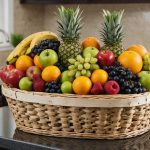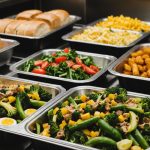Effective Fridge Organization
Fridge organization is key to promoting healthy eating habits and simplifying food storage. By thoughtfully arranging your fridge, you ensure easier access to fresh, healthy foods, encouraging daily consumption. Start by categorizing food items into basic groups: proteins, vegetables, and snacks. This not only keeps your fridge tidy but also makes meal prep more straightforward.
Effective strategies for maintaining fridge organization involve regular checks and clean-ups. Set a dedicated day each week for this purpose. Moreover, using clear, labeled containers can vastly improve visibility, reducing the time you spend searching for specific items.
Have you seen this : Energize your calorie burning: revolutionize your cooking space with a bluetooth speaker for dancing and musical enjoyment!
To ensure cleanliness and prevent food spoilage, it’s vital to maintain the right conditions. Store proteins on the fridge’s lower shelves where it’s coldest, while vegetables thrive in the humidity-controlled crisper. Regular inspections for expired items help maintain freshness and hygiene. An organised fridge saves time, decreases food waste, and supports more consistent healthy eating patterns. With some small adjustments, a well-arranged fridge can become an asset for efficient meal planning and preparation. Consider these tips a stepping stone toward a healthier kitchen environment.
Healthy Food Selection
Selecting healthy foods during grocery shopping is vital for a balanced diet. Opt for fresh produce and whole foods instead of processed items. These choices are typically lower in unhealthy fats, salt, and sugars, providing nutrient-dense options that support overall health.
In the same genre : Elevate your health: how a multi-layered fruit basket can transform your kitchen and boost daily fruit servings
When navigating aisles, understanding food labels can empower you to make smarter decisions. Look for indicators like serving size, calorie content, and nutrient information. Values for protein, fiber, and essential vitamins can guide you toward healthier selections. Recognising terms such as “whole grain” or “no added sugars” can also steer you in the right direction.
Keeping staple items on hand can facilitate healthy meal preparation. Some excellent choices include whole grains like quinoa and brown rice, fresh or frozen vegetables, lean proteins such as chicken or tofu, and healthy fats found in nuts and avocados. These ingredients are versatile and form the base of many nutritious meals. Aim to stock a variety of colourful fruits and vegetables in your fridge. This variety not only enhances nutrient intake but also adds vibrant flavours and textures to your dishes, making eating healthily a more enjoyable experience.
Effective Fridge Organization
Organizing your fridge is crucial not merely for maintaining cleanliness but also promoting healthy eating habits. A well-arranged fridge can make healthy foods more accessible and encourage better choices. Begin by categorizing food items. Allocate specific shelves for proteins, vegetables, and snacks. This categorization ensures easy access and helps maintain a systematic approach to food storage.
Aim to keep raw meats on the lower shelves to prevent drippings onto produce and other items. Utilize crispers for fresh produce, leveraging their humidity settings to keep fruits and vegetables fresh longer. Transparent containers or clear labels can aid in quick identification, preventing forgotten food from turning into waste.
Regularly clean your refrigerator and perform a quick inventory check. This ensures you are not only maintaining cleanliness but also making room for new, healthy foods and avoiding potential overstock and spoilage. Keeping an organized fridge is a practical step towards fostering healthier dietary habits, ensuring you have healthier options front and center when mealtime approaches. Implementing these food storage tips will streamline your kitchen routine and potentially improve your family’s overall nutrition.
Portion Control Techniques
Effective portion control plays a crucial role in meal planning and maintaining a balanced diet. One practical method involves using portion-controlled containers. These containers assist in managing serving sizes, making it easier to keep track of food intake and maintain healthy portions without guesswork.
Mindful eating involves being present and conscious of your eating habits. Techniques such as eating slowly and savouring each bite can enhance this process. Practising awareness helps reduce overeating by allowing your body time to signal fullness, ensuring you consume just the right amount.
Pre-portioning meals is another strategy worth embracing. It entails dividing large-batch cooked meals into individual servings ahead of time, which streamlines daily food preparation and ensures consistent portion control.
The benefits of these approaches are manifold. Firstly, they help in maintaining healthy weight levels by preventing excess food consumption. Secondly, they provide convenience, reducing stress around meal decisions. Lastly, adopting portion control techniques promotes more thoughtful eating habits, aligning meal choices with nutritional goals. Implementing these strategies can transform your eating patterns, bringing balance and structure to your daily dietary routines.
Effective Fridge Organization
Maximising fridge organization is vital for simplifying food storage and enhancing healthy eating habits. A systematically arranged fridge facilitates easier access to nutritious choices, promoting better dietary decisions. Begin by categorising foods into clear sections, such as proteins, vegetables, and snacks. This method creates a visually organised space, allowing quick access and reducing mealtime stress.
Proper storage is essential—store proteins on the lowest shelves where it’s coldest and reserve crispers for vegetables to utilise their humidity control, extending freshness. Maintain cleanliness with regular wipe-downs and check for expired items weekly to prevent contamination and spoilage.
To maintain an organised fridge, employ transparent or labelled containers for better visibility and prevention of food waste. This strategy ensures you can easily identify and use ingredients before they spoil.
Adopting these strategies not only enhances cleanliness but also supports consistent access to healthy foods, facilitating efficient meal planning. Ultimately, a well-organised fridge streamlines meal prep and reinforces healthier eating patterns by making nutritious options readily available.
Meal Preparation Strategies
Efficient meal prep can drastically reduce daily kitchen time, leaving more moments to savour nutritious dishes. To kick off, plan your weekly meals using a dedicated schedule that reflects on your typical eating patterns and preferences. This prevents unnecessary waste and keeps your kitchen routine focused. Engage in batch cooking methods, which streamline meal prep by allowing multiple servings of staples like grains, proteins, or stews to be cooked at once. These components can then be mixed and matched throughout the week for variety and balance.
For instance, cook a large pot of quinoa and chicken breast, then use them in a variety of recipes such as salads, stir-fries, or wraps. This approach minimises time spent cooking each day while ensuring the availability of home-prepared meals. Try to incorporate easy recipes—like veggie-filled omelets or one-pot pastas—that require minimal ingredients and steps yet provide full flavours and nutrients. Ultimately, these strategies not only save time but promote healthier lifestyles by keeping convenient, nutritious options at hand throughout the week, supporting both individual wellness goals and household eating habits.
Meal Preparation Strategies
Effective meal preparation is key to achieving a balanced diet while saving time and reducing stress. By planning meals weekly, you minimise food waste and optimize your grocery shopping to ensure you have the necessary ingredients on hand. A successful meal prep starts with creating a menu for the week. This allows you to batch cook essential components such as proteins and whole grains, which can be repurposed across different meals.
Batch cooking is an efficient practice that involves preparing large quantities of food that can be stored and used throughout the week. Cooking staples like chicken breast, quinoa, or roasted vegetables in bulk can make meal assembly quicker and more convenient. These components form the base for numerous recipes, reducing the need for daily cooking and ensuring you have consistent access to nutrient-rich meals.
Incorporating simple, healthy recipes into your preparation routine can make meal prep enjoyable and straightforward. Options like vegetable stir-fries, grain bowls, or hearty salads can easily be made in advance and tailored to your taste preferences. By committing to these strategies, you’ll streamline your kitchen routine and support healthier eating habits.
Cooking and Storage Tips
When it comes to food storage, employing proper techniques can significantly extend the shelf life of your ingredients. For instance, storing leftovers in airtight, transparent containers helps maintain freshness and allows easy identification of meals, promoting healthy eating habits by making nutritious options visible and accessible.
Best Practices for Storing Leftovers
To avoid spoilage, promptly refrigerate or freeze leftovers in portions after cooking. This practice not only preserves quality but suits meal prep scenarios by providing ready-to-eat servings. Remember, each type of food has ideal storage guidelines:
- Proteins: Best stored in the coldest part of the fridge.
- Vegetables: Ideal for crispers with adjustable humidity settings.
Temperature Settings
Befitting temperature control is crucial. Keep your fridge at or below 5°C (41°F) and your freezer at -18°C (0°F) to maintain food quality. Correct settings prevent bacterial growth, ensuring food stays fresh longer.
Adhering to these tips maximises shelf life and enhances meal planning efficiency. As a solution-oriented approach, it aligns food storage with fridge organization, streamlining access to healthy ingredients while reducing waste.
Cooking and Storage Tips
Adopting effective food storage techniques can significantly enhance both your culinary experience and the shelf life of your groceries. By understanding proper storage methods, you help extend the freshness of your ingredients, making meal preparation more efficient.
Best Practices for Storing Leftovers
Safeguarding your leftovers is essential to avoid unnecessary spoilage. To maximise freshness, use airtight containers and refrigerate perishable items promptly. Temperature settings also play a crucial role in preserving food quality; keep your fridge at or below 4°C (39°F) to inhibit bacterial growth.
Visibility with Transparent Containers
Utilising transparent containers not only aids in quickly identifying food but also reduces the likelihood of forgetting items stashed away. This practice not only saves time but also decreases potential food waste.
Maximising Shelf Life
Ensure to regularly monitor the fridge’s content and follow the “First In, First Out” principle, which involves using older ingredients before newer ones. This technique aids in maintaining a consistent rotation of goods, preventing spoilage.
Incorporating these storage tips ensures that your food remains fresh longer, helping to sustain healthier eating habits and efficient meal planning.
Minimizing Food Waste
Efficiently reducing food waste not only benefits the environment but also saves money. By understanding expiration dates and employing the FIFO (First In, First Out) method, you can better manage food longevity. Arrange older groceries at the front to ensure they’re used before newer items.
To further combat waste, consider repurposing leftovers. Transform surplus proteins into hearty soups or stews, and reuse vegetables in stir-fries or omelets. These techniques allow you to enjoy delicious meals while minimizing waste.
Smart shopping is another key to reducing excess purchases. Create a detailed list to avoid impulsive buys and focus on necessary items. Additionally, purchase smaller quantities of perishable goods if you’re unlikely to use them quickly. This prevents spoilage and supports sustainable practices.
Consider buying in bulk only for items with long shelf lives, like grains or canned goods. This approach can reduce packaging waste and lower overall costs. By implementing these strategies, you can contribute to more sustainable food systems and enhance your culinary creativity, making the most out of every grocery shopping trip.











